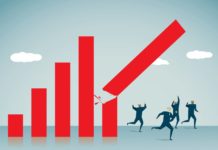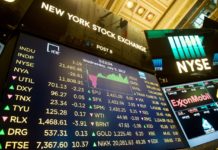Time to create your “wish list” list of stocks you’d love to buy if only they weren’t so expensive.
Humanity survived the Black Plague, smallpox and the 1918 flu, so it’s going to survive coronavirus.
Therefore, while you sit safely at home avoiding exposure to people in public places, you may as well log in to your online brokerage account and take advantage.
Is the Corona Virus Killing (For Now) the Era of Growth Stock Investing?
The Dow Jones more than quadrupled from its Great Recession, March 2009 low to last week’s record high of 29,551. That growth was largely driven by the so-called FAANG stocks – Facebook, Apple, Amazon, Netflix, and Google. Plus various other tech-related stocks such as Tesla.
However, those stocks are expensive by any measure except their perceived prospects for future growth.
Will That Bring Value Investing Back Into Fashion?
Studies show value investing beats growth investing in the long run, but many stock market participants think the “long-run” means next quarter, not 25+ years.
Therefore, after ten years of underperformance, value investing has lost a lot of popularity.
But the current situation may change that, at least temporarily.
With many people worried about the real economic problems the coronavirus is causing, stock market prices have fallen. As I write this on Thursday, the market is down another 1,100 points. Nobody knows when the bleeding will stop. With coronavirus’s two-week incubation period, even when it dies down, there will be a long period of uncertainty before we can be sure we’re safe again.
What is Value Investing?
Traditional value investing is the brainchild of Benjamin Graham, who got rich in the 1930s by finding and buying stocks selling for bargain-basement prices.
He looked below the surface of a company and its price action. He analyzed the company balance sheets to discover assets the market as a whole was not aware of.
As I recall, in one example he found a company that held an asset unrelated to its main business – a gravel pit. Not very sexy, but the gravel pit made money, and nobody else on Wall Street knew about it. So Graham in effect got it free by buying the stock.
The basic idea is often expressed as paying $1 for $2. If you could do that, how many $1 bills would you beg or borrow?
It sounds great to spend $1 for a company’s stock and, as a business owner, receive $2 in return. But how does it work out in reality?
Mr. Market
One of Graham’s concepts was Mr. Market, who has a bad case of bipolar affective disorder.
Some days he’s what used to be called “manic.” He loves stocks at any price and will buy buy buy no matter what the price. (Late 1920’s and late 1990’s).
On his down days, he hates stocks and sells everything for whatever price he can get. (Black Tuesday, Black Monday, the Tech Wreck, the Great Recession).
These market overreactions create buying and selling opportunities, according to Graham.
Or, as Warren Buffett famously puts it: “Be fearful when others are greedy and greedy when others are fearful.”
The Basic Concept
Thanks to Mr. Market’s bipolar disorder, value does not always equal price.
Value investors profit by taking advantage of the difference between them.
Value Investing Step by Step
Determine the intrinsic value of a company’s stock.
Compare that to the current stock market price.
If the intrinsic value of a stock is higher than the current market price – buy.
When the intrinsic value of a stock is lower than the current market price – sell (if you already own it, or go short if you can.)
You may notice the big “catch” with this idea – how do you calculate the “intrinsic value” of a stock?
Many books have been written about this. No method is perfect, because a stock’s intrinsic value depends on the company’s future business performance – which is impossible to predict with certainty.
Graham’s Most Famous Student
When he took Graham’s university class in investing, Warren Buffett received the only A the professor ever awarded.
And, Buffett says, he used Graham’s teachings to make his many billions of dollars.
However, Charlie Munger convinced him to value companies based on their earnings as on-going businesses, not as mere collections of assets that could be sold off.
Clearly, doing so has made them both wealthy beyond the comprehension of most of us.
The Modern World
Unlike Ben Graham, however, we have machines known as “computers.” They allow you to analyze the balance sheets of all the companies on Wall Street.
For ordinary investors, the downside is, the Big Boys in hedge funds, mutual funds, Wall Street firms and so on also have computers. More computers and more powerful computers. And they hire math and finance wizards, not to mention people working on the cutting edge of Artificial Intelligence.
You’re not going to find many companies with gravel pits that Ray Dalio of Bridgewater Associates, the world’s largest hedge fund, is overlooking.
These Days, Mr. Market Usually Takes His Meds
If you had lots of money, you could have gotten rich in the 1930s just by buying up good companies at any price, then waiting for prosperity to return.
Same with 1973-1974, the 21% drop in October 1987, the Tech Wreck of 2000 and the Great Recession of 2008-2009.
But most people invest bit by bit, paycheck deduction by paycheck deduction. It’s hard to hold on to a large chunk of cash waiting for the Next Big Crash before you buy.
If that’s you, you’ve missed out on all the market growth and dividends of the last 10 years.
For the past ten years, Mr. Market has had up days and down days. but has mostly been happy. And he’s avoided the hypermania he went through during the late 1990’s Dot Com Buble and the extreme blues he suffered during the Great Recession of 2008-2009.
Until the coronavirus hit, prospects for both the economy and this year’s stock market looked good.
Eventually, the coronavirus will go away or we’ll learn to adapt to it (maybe we’ll just suffer through it every winter along with colds and the flu).
Therefore, the Corona Crash may be your best chance to grab bargains before the market surges again.
But I can’t predict the bottom. Maybe it happened today, maybe not.
Nobody knows the future.
But unless the coronavirus wipes out civilization as we know it, stocks and the economy will recover.








